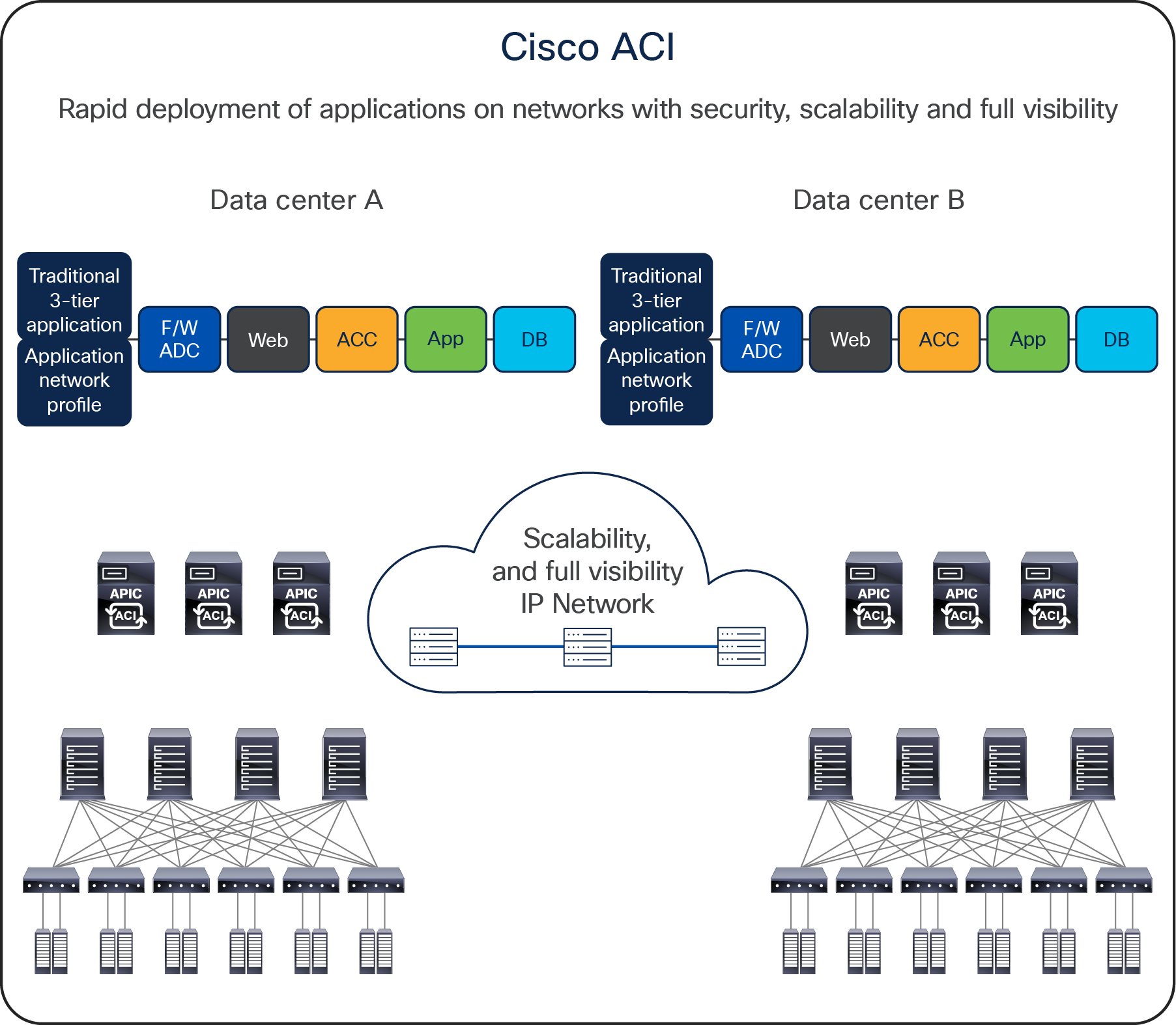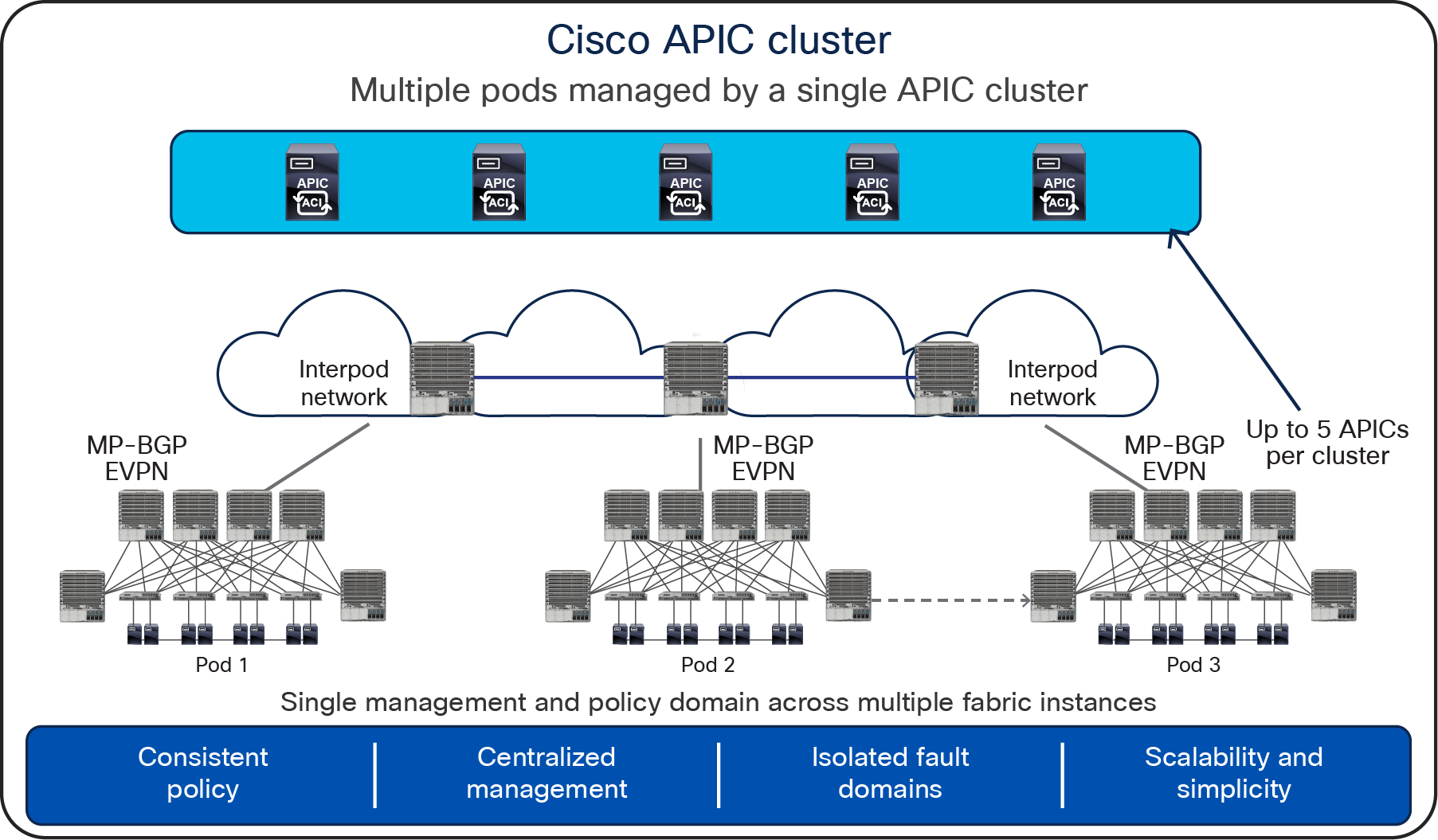Cisco Application Policy Infrastructure Controller Data Sheet
Available Languages
Bias-Free Language
The documentation set for this product strives to use bias-free language. For the purposes of this documentation set, bias-free is defined as language that does not imply discrimination based on age, disability, gender, racial identity, ethnic identity, sexual orientation, socioeconomic status, and intersectionality. Exceptions may be present in the documentation due to language that is hardcoded in the user interfaces of the product software, language used based on RFP documentation, or language that is used by a referenced third-party product. Learn more about how Cisco is using Inclusive Language.
The Cisco® Application Centric Infrastructure (Cisco ACI®) is part of our intent-based networking framework to enable agility in the datacenter. It captures higher-level business and user intent in the form of a policy and translates this into the network constructs necessary to dynamically provision network, security, and infrastructure services.
Built on top of the industry-leading Cisco Nexus® 9000 platform, Cisco ACI uses a holistic systems-based approach, with tight integration between hardware and software, between physical and virtual elements, an open ecosystem model, and innovative Cisco Application-Specific Integrated Circuits (ASICs) to enable unique business value for modern data centers.
Cisco ACI is the industry’s most secure, open, and comprehensive Software-Defined Networking (SDN) solution.
ACI enables automation that accelerates infrastructure deployment and governance, simplifies management to easily move workloads across a multifabric, multicloud framework, and proactively secures against risk arising from anywhere. It radically simplifies, optimizes, and expedites the application deployment lifecycle.
Modern data centers are dynamic. IT operations must meet the expectation of quality-of-service business needs in a rapidly changing environment. ACI transforms IT operations from reactive to proactive with a highly intelligent set of software capabilities that analyzes every component of the data center to ensure business intent, guarantee reliability, and identify performance issues in the network before they happen.
As application usage gets more pervasive across an enterprise’s network, IT professionals are looking to build solutions for consistent policy and encryption from the campus to the datacenter. With ACI integrations with SDA/DNA Center and SD-WAN, customers can now automate and extend policy, security, assurance, and insights across their entire networking ecosystem.
The Cisco ACI solution consists of the following building blocks (Figure 1):
● Cisco Application Policy Infrastructure Controller (APIC).
● Cisco Nexus 9000 Series spine and leaf switches for Cisco ACI.
● Cisco Nexus Dashboard

Cisco ACI architectural building blocks
Cisco Application Policy Infrastructure Controller (APIC) features
The main features of the APIC include the following:
● Application-centric network policies.
● Data-model-based declarative provisioning.
● Application and topology monitoring and troubleshooting.
● Third-party integration.
◦ Layer 4 through Layer 7 (L4-L7) services.
◦ VMware vCenter and vShield.
◦ Microsoft Hyper-V, System Center Virtual Machine Manager (SCVMM), and Azure Pack.
◦ Open Virtual Switch (OVS) and OpenStack.
◦ Kubernetes, Red Hat OpenShift, Docker Enterprise.
● Image management (spine and leaf).
● Cisco ACI inventory and configuration.
● Implementation on a distributed framework across a cluster of appliances.
● Health scores for critical managed objects (tenants, application profiles, switches, etc.).
● Fault, event, and performance management.
● Isovalent® Cilium and eBPF integration for end-to-end observability
The controller framework enables broad ecosystem and industry interoperability with Cisco ACI. It enables interoperability between a Cisco ACI environment and management, orchestration, virtualization, and L4-L7 services from a broad range of vendors.
The APIC appliance is deployed as a cluster. A minimum of three infrastructure controllers are configured in a cluster to provide control of the scale-out Cisco ACI fabric (Figure 2). The ultimate size of the controller cluster is directly proportionate to the size of the Cisco ACI deployment and is based on the transaction-rate requirements. Any controller in the cluster can service any user for any operation, and a controller can be transparently added to or removed from the cluster.

Cisco APIC cluster
APIC appliance product specifications
The APIC appliance is available in different form factors (Table 1):
| Cisco APIC configuration |
Part number |
Description |
| Medium M4 |
APIC-M4 |
APIC with medium-size CPU, hard drive, and memory configurations (up to 1200 edge ports) |
| Large L4 |
APIC-L4 |
APIC with large CPU, hard drive, and memory configurations (more than 1200 edge ports) |
| Medium cluster M4 |
APIC-CLUSTER-M4 |
Cluster of 3 APIC-M4 with medium-size CPU, hard drive, and memory configurations (up to 1200 edge ports) |
| Large cluster L4 |
APIC-CLUSTER-L4 |
Cluster of 3 APIC-L4 with large CPU, hard drive, and memory configurations (more than 1200 edge ports) |
| APIC G5 node |
APIC-SERVER-G5 |
Fifth-Generation APIC (combined appliance; no medium/large with this generation) |
| APIC G5 cluster |
APIC-CLUSTERG5 |
Cluster of three Fifth-Generation APIC’s (combined appliance; no medium/large with this generation) |
Table 2. Specifications of the APIC G5 combined appliance. Note that at least three appliances need to be configured as a cluster.
| APIC G5 (combined appliance) |
Description |
Default units |
| Processor |
AMD 9354P 3.25GHz 280W 32C/256MB cache DDR5 4800MT/s |
1 |
| Memory |
32GB DDR5-5600 RDIMM 1Rx4 (16Gb) |
8 |
| Hard Drive |
1.6TB 2.5in U.3 15mm P7450 high-perf high-end NVMe (3X) |
2 |
| PCI Express (PCIe) slots |
Cisco VIC 15425 4x 10/25/50G PCIe C-Series w/secure boot |
1 |
| Power supply |
1200w AC titanium power supply for Cisco UCS® C-Series rack servers |
2 |
Table 3. Cisco APIC G5 physical and environmental specs
| Overview |
Description |
| Physical dimensions (H x W x D) |
1 rack unit (1RU): 1.7 x 16.9 x 30 in. (4.3 x 42.9 x 76.2 cm) |
| Temperature: Operating |
41°F to 95°F (5°C to 35°C) (operating, at sea level, with no fan fail and no CPU throttling, and with turbo mode) |
| Temperature: Nonoperating |
Dry bulb temperature of -40°F to 149°F (-40°C to 65°C) |
| Humidity: Operating |
8% to 90% noncondensing |
| Humidity: Nonoperating |
5% to 93% noncondensing |
| Altitude: Operating |
0 to 10,006 ft (0 to 3050 meters); maximum ambient temperature decreases by 1°C per 300m |
| Altitude: Nonoperating |
0 to 39,370 ft (12,000m) |
Table 4. Specifications of the APIC M4 and L4 appliance. Note that at least three appliances need to be configured as a cluster

|
|
Medium configuration: M4 |
|
Large configuration: L4 |
|
|
|
Description |
Default units |
Description |
Default units |
| Processor |
AMD 3.0GHz 7313P 155W 16C/128MB Cache DDR4 3200MHz |
1 |
AMD 2.85GHz 7443P 200W 24C/128MB Cache DDR4 3200MHz |
1 |
| Memory |
16GB RDIMM SRx4 3200 (8Gb) |
6 |
32GB RDIMM DRx4 3200 (8Gb) |
6 |
| Hard Drive |
480GB 2.5in Enterprise Performance 6GSATA SSD (3X endurance) 960GB 2.5in Enterprise performance 6GSATA SSD (3X endurance) |
1 each |
480GB 2.5in Enterprise Performance 6GSATA SSD(3X endurance) 1.6TB 2.5in U.2 WD SN840 NVMe Extreme Perf. High Endurance |
1 each |
| PCI Express (PCIe) slots |
Intel E810XXVDA2 2x25/10 GbE SFP28 PCIe NIC Intel X710T2LG 2x10 GbE RJ45 PCIe NIC |
None- Configurable Options |
Intel E810XXVDA2 2x25/10 GbE SFP28 PCIe NIC Intel X710T2LG 2x10 GbE RJ45 PCIe NIC |
None-Configurable Options |
| Power supply |
1050W (AC and DC) and 1600 W |
1 |
1050W (AC and DC) and 1600 W |
1 |
| FAN |
Eight hot-swappable fans |
|||
| Airflow |
Front to rear cooling |
|||
Table 5. Cisco APIC M4 and L4 Physical and Environmental Specs
| Overview |
Description |
| Physical Specifications |
1 Rack Unit (RU), Height (43.2 mm), Width 16.9 in. (429.0 mm), Depth (length) Server only: 29.5 in. (740.3 mm) |
| Temperature: Operating |
10° C to 35° C (50° F to 95° F) with no direct sunlight |
| Temperature: Nonoperating |
Below -40° C or above 65° C (below -40° F or above 149° F) |
| Humidity (RH): Operating |
8 to 90% and 24° C (75o F) maximum dew-point temperature, non-condensing environment |
| Humidity (RH): Nonoperating |
Below 5% or above 95% and 33o C (91o F) maximum dew-point temperature, |
| Altitude: Operating |
0 to 10,000 feet |
| Altitude: Nonoperating |
0 to 40,000 feet |
Table 6. Cisco medium form factor virtual APIC requirements
To use the APIC controller as a virtual form-factor or in AWS cloud, a DCN-vAPIC license is required. A minimum of three licenses are required for a cluster, and additional licenses can be ordered for expanding the cluster.
| Cisco Virtual APIC Requirements |
Description |
| Processor |
16 vCPU of 3 GHz or Higher |
| Memory |
96 GB of RAM |
| DiskSpace |
Disk 1: SSD or NVMe – 120GB (root disk) Disk 2: SSD or NVMe – 360GB (data disk) I/O latency of 20ms |
| ESxi |
7.0 |
Cisco environmental sustainability
Information about Cisco’s environmental sustainability policies and initiatives for our products, solutions, operations, and extended operations or supply chain is provided in the “Environment Sustainability” section of Cisco’s Corporate Social Responsibility (CSR) Report.
Reference links to information about key environmental sustainability topics (mentioned in the “Environment Sustainability” section of the CSR Report) are provided in the following table:
| Sustainability topic |
Reference |
| Information on product material content laws and regulations |
|
| Information on electronic waste laws and regulations, including products, batteries, and packaging |
Cisco makes the packaging data available for informational purposes only. It may not reflect the most current legal developments, and Cisco does not represent, warrant, or guarantee that it is complete, accurate, or up to date. This information is subject to change without notice.
Flexible payment solutions to help you achieve your objectives
Cisco Capital® makes it easier to get the right technology to achieve your objectives, enable business transformation and help you stay competitive. We can help you reduce the total cost of ownership, conserve capital, and accelerate growth. In more than 100 countries, our flexible payment solutions can help you acquire hardware, software, services and complementary third-party equipment in easy, predictable payments.
Learn more.
Use the following links for additional information:
● Cisco ACI solution data sheet: Click here.
● Cisco ACI ordering guide: Click here.
● Cisco Nexus 9000 Series Switches data sheet: Click here.
● Cisco Nexus Dashboard data sheet: Click here.
● Cisco ACI solution general details: Click here.
● Technical white papers: Click here.
● Case studies: Click here.
● Solution overviews: Click here.
● YouTube video tutorials: Click here.
● Release notes for Cisco ACI and APIC solutions: Click here.
● Release notes for Cisco Nexus 9000 Series Switches: Click here.
● Download Cisco ACI software: Click here.
| New or Revised Topic |
Described In |
Date |
| Remove XS Cluster, Medium Spare and Large Spare PIDs. Update the table with APIC-M4/L4 PIDs |
February 1, 2023 |
|
| Change the heading to "Cisco APIC M3 and L3 Physical and Environmental Specs |
February 1, 2023 |
|
| Added additional specs |
February 1, 2023 |
|
| Revised name for Cisco Cloud APIC to Cisco Cloud Network Controller |
Cisco Network Controller Product Specifications |
February 1, 2023 |